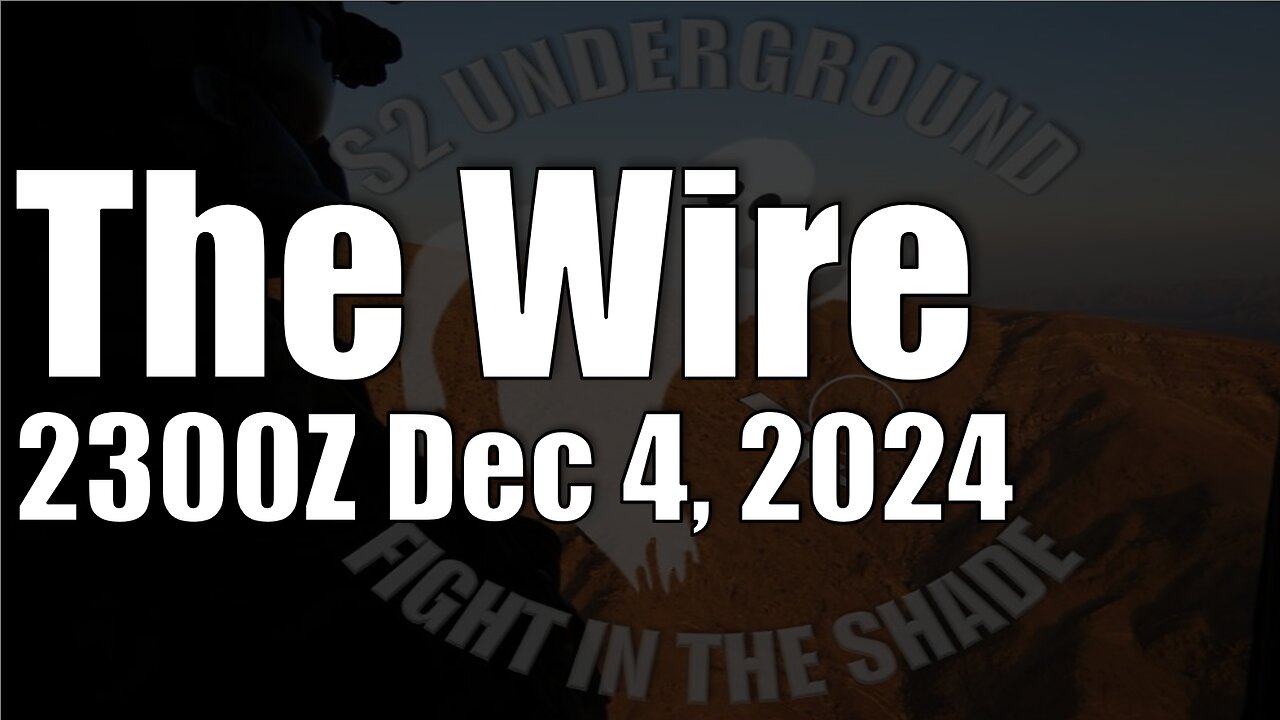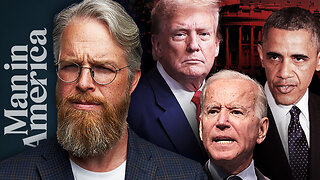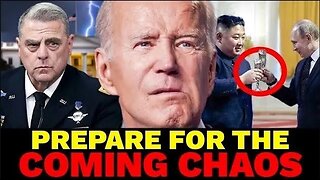Premium Only Content

The Wire - December 4, 2024
//The Wire//2300Z December 4, 2024//
//ROUTINE//
//BLUF: SITUATION IN SOUTH KOREA SOMEWHAT STABILIZED AS DEVELOPMENTS CONTINUE. UNITED HEALTHCARE CEO ASSASSINATED IN NYC. HAMA IN DANGER OF ENCIRCLEMENT IN SYRIA.//
-----BEGIN TEARLINE-----
-International Events-
Syria: Rebel forces continue their assault on Hama as Russian forces continue to lose terrain and equipment. This morning, rebel forces allegedly photographed the capture of a Podlet K1 radar system in Hama, which is used in conjunction with S300/S400 air defense systems. AC: By this afternoon, it appears that Hama may be close to becoming encircled by rebel forces, with the only point of egress to the south of the city becoming threatened by HTS forces which have pushed south from the east and west of the city in a classic pincer movement throughout the day.
South Korea: The impacts from yesterday’s events continues to be felt throughout Seoul as lawmakers begin impeachment proceedings against President Yoon. So far, the military situation has reached a point of stability, though it is uncertain as to who has been arrested so far.
-HomeFront-
New York: The CEO of United Healthcare Brian Thompson was assassinated this morning by an unknown assailant on the sidewalk outside of the Hilton Midtown hotel. The assassin remains at large. AC: Of note, this incident appears to be a more professional assassination and not an incident of random street crime.
-----END TEARLINE-----
Analyst Comments: The additional details that have become public during yesterday’s rapid-pace of events in South Korea have been interesting. In typical South Korean fashion, the situation has mostly been a rollercoaster of events, with many power-players changing perspectives and positions in rapid order. The coup-that-never-was continues to be a series of exceptionally strange events that do not adhere to the normally-observed characteristics of a full-blown military coup.
Militarily speaking, the exact military units that took part in the failed coup attempt remain unidentified. Following the high-tensions in the morning, throughout the day other unidentified military forces were observed outside the homes of prominent opposition politicians as well as many journalists. Separately, several RoK defense officials stated that they had no idea what was happening at the time, and only heard of the activities at the National Assembly Building from the local news broadcasts.
This could indicate several possibilities that are usually inherent to similar coup attempts such as this one. For one, many of the generals who were indeed supportive of Yoon during this crisis will undoubtedly remain silent now that Yoon’s attempt failed. On the other hand, compared to the actual size of South Korea’s military, and the speed at which events transpired, it is very likely that most of the military (probably to include many senior leaders) actually did not know what was happening, and therefore had no hand in any of this.
Additional details complicate the involvement of military forces. For instance, some of the teams that breached the windows and gained entry into the National Assembly Building appeared to have been outfitted with weapons that were for training purposes. Specifically, some citizens were able to photograph the configuration of some of the soldiers’ weapons, which indicated that at least several of them were outfitted with training bolts. This means that in at least some cases, soldiers were incapable of firing live rounds, but rather outfitted in a training role. Other soldiers were observed to have no magazines in their sidearms as well.
This detail complicates the picture significantly, with a few possibilities remaining plausible. The deployment of troops to the National Assembly Building could have been a very dangerous bluff, with the soldiers never really intending to militarily overthrow anyone, but rather to arrest the President’s opposition. After all, when launching a very-serious and deliberate military coup in the most literal of senses, it’s generally advised to do so with actual live rounds in one’s firearm. However, even to do this would be exceptionally dangerous to the soldier…to a civilian, in the heat of the moment, when windows are being shattered and soldiers are breaking through barricades, a military force may just find out the true meaning of what a resistance might look like.
Likewise, the complete silence and lack of any action from Yoon for several hours during this crisis was perplexing. History very strongly indicates that when one launches a coup, time is of the essence. One must go all-in, or not at all, so to speak. President Yoon, sending a few platoons of troops and a handful of helicopters to arrest his political opposition…but also not really doing anything more than that very strongly indicates that he did not take the initiative to actually achieve his goals.
The three helicopters that were observed mobilizing to the National Assembly Building landed at the soccer field to the northwest of the building. Despite earlier reports, no other aircraft appeared to have taken part in yesterday's events. Of note, a substantial amount of older footage circulated on social media during the incident, leading many to believe that mechanized infantry had deployed to the capitol region. This did occur to some degree, as protesters did observe some armored cars maneuvering to take up station in the capitol region, however many of the video clips showing substantial movement of Infantry Fighting Vehicles (IFVs) were older clips from a previous military exercise.
Regarding what President Yoon’s actual plan was, this largely remains a mystery. Though highly speculative, it is possible that his general idea was to roughly follow the plot of an old WWII story, the tale of Operation Valkyrie. This was an operation that was conceived in Germany late in the war, as a way of ousting Hitler and seizing control of the government. The plan involved invoking a secret continuity-of-governance plan that would allow certain leadership to (in an emergency) take over command of the government and oust any loyalists.
At face value, this could be what Yoon tried to do, at least partly. The obvious major difference is that he was not intending to unseat himself, but rather leverage South Korea’s well known response plans to his advantage, to solidify power.
Though again this is very speculative at this time, this could account for the varying levels of involvement by military forces. Some loyalist units probably deployed to the National Assembly Building in the same way that they would enact wartime plans of a Communist invasion. Generally speaking, South Korea’s entire military hierarchy, infrastructure, and ideology is built around one idea…combatting a North Korean invasion. As such, South Korea has extensively detailed plans for continuity of governance, in the event that war were to break out again. The President (being the Commander in Chief of the armed forces) knows this, which is why he may have sought to intentionally overreact to a political issue and frame the situation as if “the Communists were coming”. This would be really the only way to achieve the desired effect of bringing in the military to support him. In short, President Yoon’s actions were probably far more significant than just a mere political stunt, but fell short of what one might expect a real coup to look like.
Either way, in the clear light of day, the progression of events has largely fallen apart and re-entered the political arena. Impeachment proceedings have begun, however President Yoon appears to be taking the position of trying to walk back his actions. Following yesterdays’ failed coup (or technically an autocoup), there are usually only two choices available to those who’s attempts fail: Flee the country, or resign immediately and hope to not be thrown in prison (or usually, worse). President Yoon seems to have opted for the third less-common option: to claim that he wasn’t serious and wants to forget the whole thing. This is most sharply evidenced by his party, which originally completely disowned him due to his actions, vowing to oppose an impeachment effort. At the present moment, President Yoon seems to believe that he may politically survive this event, whatever it actually was.
If Yoon indeed wanted to overthrow his own government to stay in power, he did everything incorrectly. He hesitated, allowed comms to remain, didn’t have (or even notify) most military leadership, and sent not nearly enough troops to actually do anything. On the other hand, if this was a grand political stunt, the South Korean people are well within their purview to have thought that armed soldiers and helicopters were a legitimate (and lethal) coup attempt. In any society on Earth, certain unspoken Rules of Engagement come about on a human instinctive level….if a soldier points a weapon at their own citizenry, training rounds or not, that citizenry is well within their instincts to treat that as a legitimate threat and respond accordingly. When armed soldiers are introduced into a situation, rules and regulations no longer matter. Rightly or wrongly, the people in the National Assembly Building, and those demonstrating outside, thought this was real. Gaslighting the people into thinking this was just a political stunt probably won’t fly even in South Korea. This is why President Yoon has faced such scrutiny over this incident; things could have turned out very differently than they did. It is a miracle that no one was killed during yesterday’s events; South Korea probably got closer to the precipice than any other nation in recent memory, without actually going over the edge. This may take some time for even South Korean citizens to realize, who may be used to the less-serious tradition of crazy political events being relatively normal. This case however, may prove to be quite different in due time. More poignantly, these events provide a very important case-study for examination by citizens everywhere.
All in all, this event was beyond the pale of normalcy, even for South Korean politics which tends to be rather kinetic and interesting by western standards. On the other hand, if there ever was a place where a President can launch an armed military coup and declare martial law, only to essentially say “just kidding” (and that actually work) it would be in South Korea.
More broadly, a completely unspoken detail that remains extremely relevant revolves around what the United States was up to during this crisis. RoK SOF and American advisors/counterparts are exceptionally closely intertwined, probably moreso than any other American military partnership around the world. Nothing happens on the Korean Peninsula, in the North or South, without at least a dozen different U.S. military commands (from all service branches) knowing about it and being directly involved to some degree. As these details become more public, it will be important to examine what the role of the United States was during this crisis.
Analyst: S2A1
//END REPORT//
-
 14:53
14:53
S2 Underground
3 days agoThe Wire - December 11, 2024 - Priority
1.18K10 -
 48:02
48:02
Man in America
15 hours agoWill Trump FINALLY Prosecute the 2020 Election Criminals? w/ FEC Commissioner Trey Trainor
87.1K75 -
 12:51
12:51
Tundra Tactical
13 hours ago $31.29 earnedNYC Killer: Guilty or Patsy?
98.4K16 -
 26:09
26:09
MYLUNCHBREAK CHANNEL PAGE
1 day agoThe Hidden Tunnels of Osiris
130K59 -
 2:42:35
2:42:35
Jewels Jones Live ®
1 day agoLAWFUL DRONES | A Political Rendezvous - Ep. 102
172K36 -
 4:22:48
4:22:48
Pepkilla
18 hours agoWarzone Ranked Road to 250 ~ HaLLLLPPPPP
122K5 -
 2:14:38
2:14:38
SLS - Street League Skateboarding
9 days ago2024 SLS Super Crown São Paulo: Men's Prelims
244K41 -
 1:11:07
1:11:07
PMG
1 day ago $17.54 earned"Alarming Parallels of Modern America and the Roman Empire | Jeremy Ryan Slate"
100K53 -
 46:39
46:39
Stephen Gardner
20 hours ago🔥FINALLY! Trump BLACKMAIL scheme EXPOSED | 'Ukraine will be DESTROYED' worries US Pentagon!
148K247 -
![Devin Nunes - Truth Social Gets An Upgrade, We Will Celebrate The Destruction Of The [DS] With Wine](https://1a-1791.com/video/s8/1/0/G/j/J/0GjJv.0kob-small-Devin-Nunes-Truth-Social-Ge.jpg) 50:15
50:15
X22 Report
21 hours agoDevin Nunes - Truth Social Gets An Upgrade, We Will Celebrate The Destruction Of The [DS] With Wine
290K306